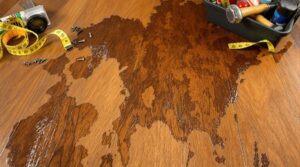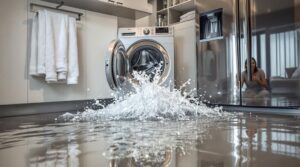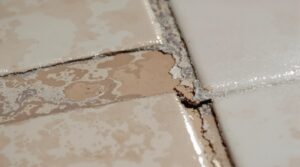Fixing cupped hardwood floors requires addressing moisture imbalance through dehumidification and proper ventilation. Moisture content must be measured using calibrated meters to assess severity, followed by controlled drying with strategic airflow placement. Once stabilized, floors need professional sanding starting with coarse-grit paper at 45-degree angles, progressing to finer grits. Final restoration involves sealer application and polyurethane coats. Understanding the complete remediation process guarantees ideal results for long-term floor stability.
Key Takeaways
- First stabilize indoor humidity between 30-50% using dehumidifiers and maintain proper ventilation to allow natural wood recovery.
- Monitor moisture content with calibrated meters until readings normalize, which may take several days to weeks.
- Once moisture levels stabilize, sand the floor at a 45-degree angle starting with coarse-grit sandpaper, progressing to finer grits.
- Apply wood sealer followed by multiple polyurethane coats, ensuring light sanding between applications for a smooth finish.
- Prevent future cupping by conducting regular moisture inspections and maintaining consistent indoor humidity levels year-round.
Understanding Cupped Hardwood Floor Causes
The telltale concave shape of cupped hardwood floors typically results from moisture imbalance between the top and bottom surfaces of the wood planks. When excessive moisture accumulates beneath the flooring, the underside expands more than the top surface, creating a characteristic cupping effect.
Multiple moisture sources can trigger this condition, including subfloor dampness, basement humidity, plumbing leaks, and inadequate humidity control. Regular moisture meter readings can identify developing issues before severe cupping occurs.
Installation-related factors also contribute notably, particularly when contractors install flooring on insufficiently dried subfloors or fail to account for seasonal humidity variations. Poor ventilation and basement moisture can create ongoing humidity challenges that exacerbate cupping issues.
Environmental conditions play a vital role, as indoor humidity levels exceeding 50% can cause wood absorption and subsequent deformation.
Proper moisture management and swift response to water-related incidents are essential for preventing this common flooring issue.
Diagnosing the Severity of Floor Cupping
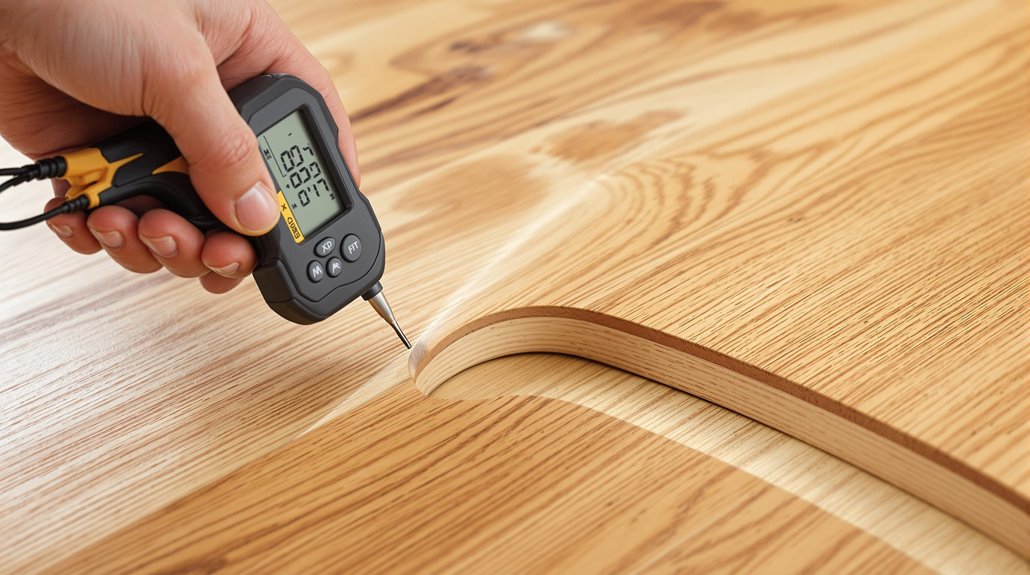
A thorough visual inspection of hardwood floors can reveal key indicators of cupping severity, including the height differential between board edges and centers, as well as any visible gaps or structural deformities. To address these issues, homeowners can explore various new hardwood floor cupping solutions that effectively restore the floors to their original condition. It’s important to act quickly, as prolonged exposure to moisture can lead to further damage. By using specialized products and techniques, such as dehumidifiers and proper acclimation methods, you can minimize the effects of cupping and extend the life of your hardwood flooring.
Professional assessment requires measuring moisture content levels using calibrated moisture meters at multiple points across the affected area to establish moisture distribution patterns.
These measurements, combined with visual data, help determine whether the cupping falls within normal parameters or requires immediate intervention. Stable indoor conditions should be maintained throughout the assessment process to ensure accurate readings.
Visual Inspection Methods
Properly diagnosing cupped hardwood floors begins with a systematic visual inspection to evaluate the severity and extent of the damage. Visual inspection techniques focus on identifying key cupping indicators across the affected areas, examining both individual boards and overall floor patterns. Using a soft-bristle broom to gently sweep the surface can help reveal subtle variations in board height and texture.
| Inspection Area | Key Indicators to Assess |
|---|---|
| Board Edges | Height variation from center, upward curling |
| Surface Profile | Characteristic U-shape deformation |
| Moisture Signs | Dark spots, discoloration patterns |
| Growth Pattern | Ring orientation, plain vs. quarter-sawn |
Professional evaluators examine wide planks with particular attention, as these typically show more pronounced cupping effects. The inspection process includes measuring the depth of cupping, documenting affected zones, and noting the presence of any structural complications that might require immediate intervention.
Measuring Moisture Content Levels
When diagnosing hardwood floor cupping, accurate moisture content measurement serves as a critical diagnostic tool for determining both severity and appropriate remediation steps.
Professional moisture measurement techniques employ either pin-type meters, which measure electrical resistance, or pinless meters that utilize electromagnetic frequencies for non-invasive scanning.
To guarantee accuracy, proper moisture meter calibration must account for specific wood species and ambient conditions.
The National Wood Flooring Association stipulates moisture content variances should not exceed 4% for solid-strip flooring or 2% for wide-width installations.
Testing protocol requires approximately 40 measurements per 1,000 square feet initially, followed by 4 readings per additional 100 square feet.
Readings should focus on board centers where moisture concentration is highest, and all measurements must be documented to track progress toward achieving equilibrium moisture content.
Essential Steps for Moisture Control
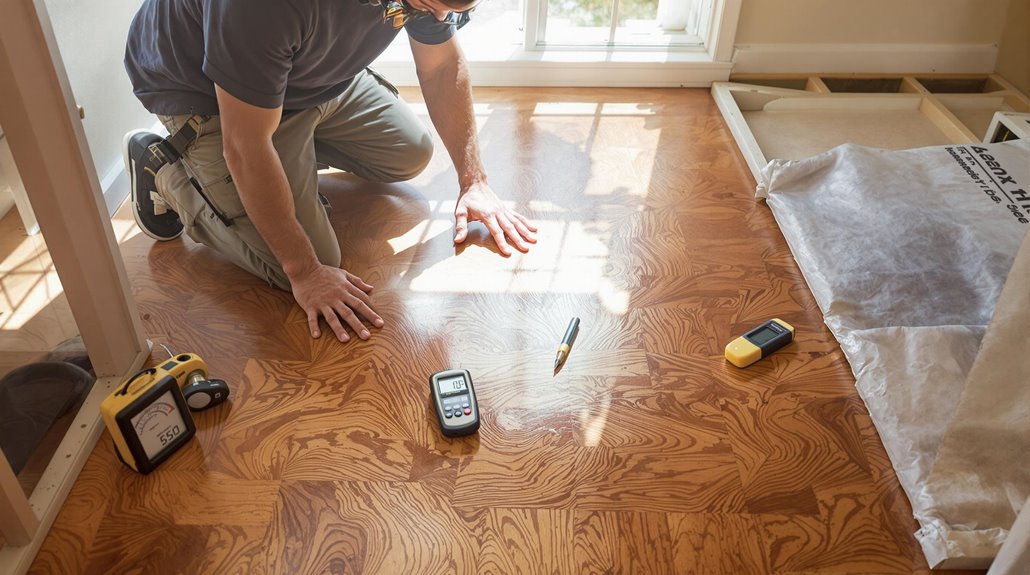
Effective moisture control begins with daily monitoring of indoor humidity levels using calibrated hygrometers to maintain the ideal 30-50% range.
Building professionals must conduct thorough inspections to identify potential water entry points, including plumbing leaks, foundation seepage, or compromised roof systems.
Installing proper vapor barriers beneath the subfloor creates an essential moisture barrier that prevents ground moisture from migrating upward through the flooring system.
Monitor Daily Humidity Levels
Maintaining ideal humidity levels stands as a critical factor in preventing and addressing cupped hardwood floors. Through consistent humidity monitoring, homeowners can guarantee their floors remain within the suitable 30-50% relative humidity range.
The implementation of moisture measurement tools, such as Floor Sentry devices and calibrated moisture meters, enables precise tracking of both surface and subfloor conditions.
Regular monitoring helps identify potential moisture issues before they lead to significant damage. Utilizing both pinless and pin-type moisture meters, along with EMC charts, provides thorough data about wood flooring's moisture content.
When deviations occur, immediate corrective measures, such as deploying dehumidifiers or addressing water sources, can prevent cupping and warping.
Professional intervention becomes necessary when moisture-related problems persist despite preventive efforts.
Identify Water Entry Points
The systematic identification of water entry points forms the foundation of any successful moisture control strategy for hardwood floors.
Professional leak detection methods include thorough visual inspections for water damage, discoloration, and compromised sealants around fixtures and appliances. Moisture meter testing reveals hidden moisture sources within subfloors and adjacent areas.
Key inspection areas include plumbing systems, roofing components, and appliance connections where water infiltration commonly occurs. Technicians must examine crawl spaces and basements for inadequate ventilation or drainage issues that contribute to moisture problems.
Special attention should focus on high-traffic zones where wet mopping or spills frequently occur. Additionally, checking gutters, downspouts, and foundation perimeters helps identify external moisture sources that may affect indoor humidity levels and flooring stability.
Install Proper Vapor Barriers
Installing proper vapor barriers represents a critical line of defense against moisture damage in hardwood flooring systems. The selection and installation of appropriate vapor barrier materials depends on the subfloor type and installation method. For concrete slabs, an epoxy coating with plastic sheeting provides peak protection, while crawl spaces require 6-mil plastic sheeting with fiberglass insulation.
| Subfloor Type | Recommended Vapor Barrier Materials |
|---|---|
| Concrete Slab | Epoxy coating + plastic sheeting |
| Crawl Space | 6-mil plastic + fiberglass batts |
| Below Grade | Engineered flooring + moisture guard |
| Wood Subfloor | Felt paper or vapor retarder |
| Floating Floor | Combo underlayment barrier |
Installation techniques must guarantee the moisture content differential between flooring and subfloor doesn't exceed 2%. Professional moisture testing and proper acclimation are essential before implementing any vapor barrier solution. Regular post-installation monitoring helps maintain long-term moisture control effectiveness.
The Drying and Recovery Process
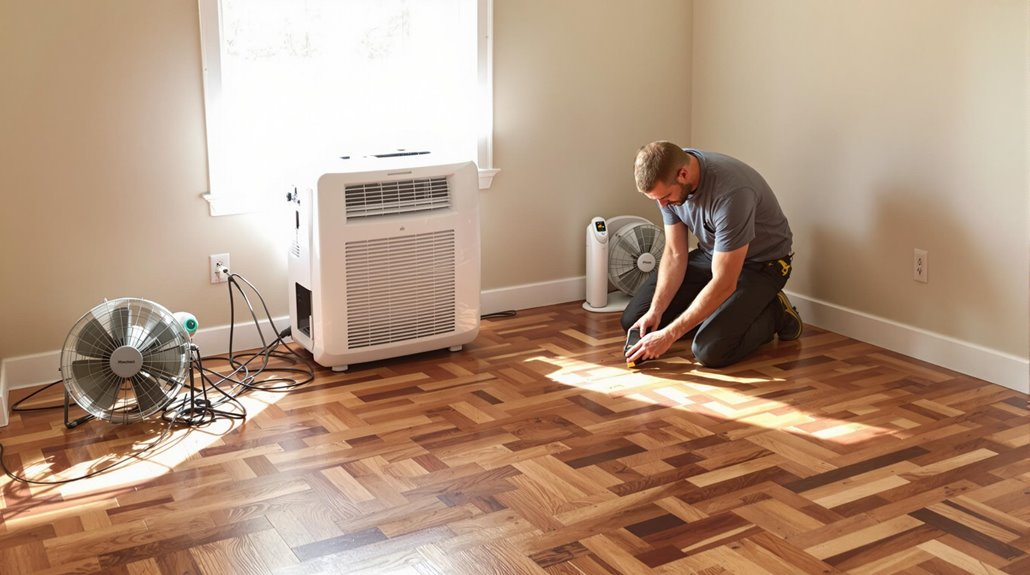
Successfully drying cupped hardwood floors requires a systematic approach that combines proper moisture management, environmental control, and patience.
The drying techniques begin with identifying and addressing the moisture source, followed by implementing targeted recovery strategies using dehumidifiers and strategic airflow placement.
The process demands careful monitoring of moisture content using specialized meters while maintaining consistent environmental conditions.
Different wood species respond uniquely to drying procedures, with recovery timelines varying from days to weeks depending on factors such as cupping severity and exposure duration.
Professional assessment becomes vital when dealing with severe cases or when initial drying efforts show minimal improvement.
Throughout the process, it is important to avoid rushed solutions and maintain steady drying conditions to prevent additional stress on the wood fibers.
Sanding and Refinishing Techniques
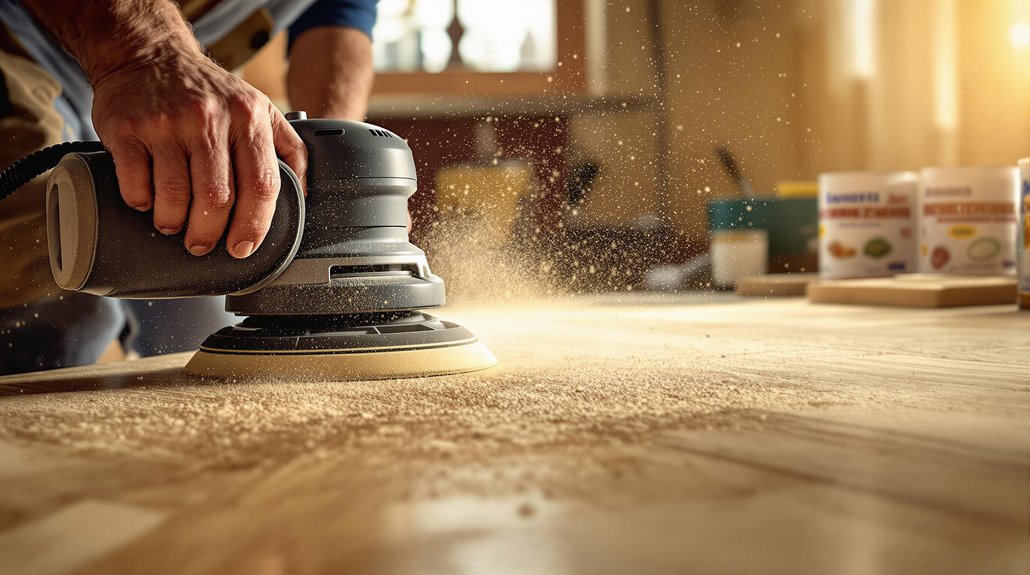
Professional sanding and refinishing represent critical steps in restoring cupped hardwood floors, requiring precise techniques and proper equipment selection to achieve ideal results.
The process begins with evaluating cupping severity and ensuring moisture levels have normalized before implementing sanding techniques.
Initial sanding passes utilize coarse-grit sandpaper (36-40 grit) at a 45-degree angle to effectively level the cupped areas. The sander must target raised ridges while maintaining even pressure to prevent over-sanding.
As work progresses, refinishing options expand through progressively finer grits until achieving optimal smoothness. Multiple passes may be necessary, particularly for severe cupping cases.
The final restoration phase involves applying wood sealer followed by polyurethane coats, with light sanding between applications. A protective varnish coating completes the refinishing process, restoring both functionality and appearance.
Prevention and Long-Term Maintenance
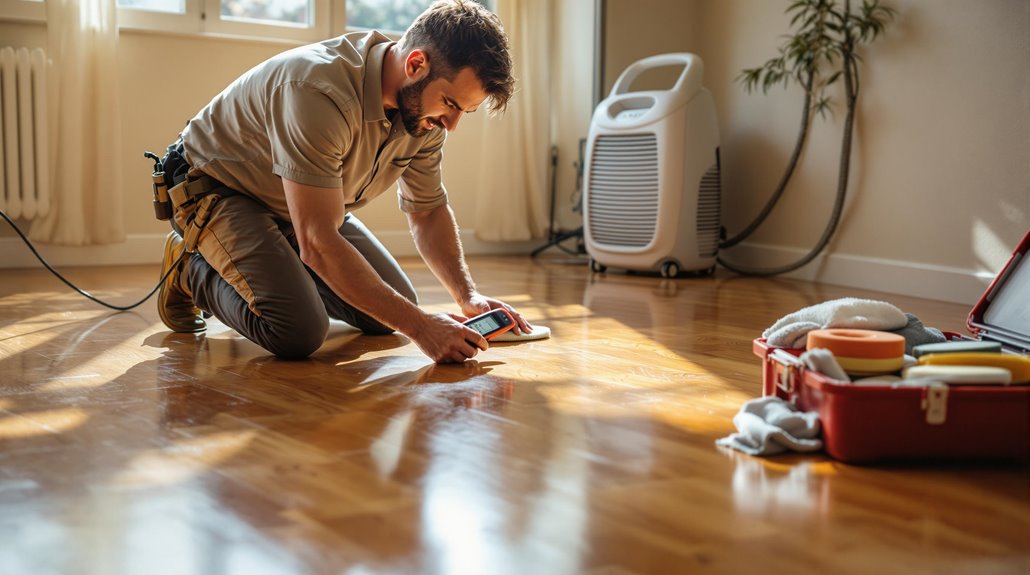
Effective prevention of hardwood floor cupping relies on four essential maintenance strategies: humidity control, proper acclimation, consistent cleaning protocols, and proactive moisture management.
Wood floor care requires vigilant monitoring of indoor environmental conditions, particularly humidity levels between 30-50%. Professional installation with proper acclimation periods and moisture-resistant underlayment establishes a foundation for long-term stability.
- Install dehumidifiers in moisture-prone areas and humidifiers in dry spaces
- Implement daily cleaning routines using slightly damp cloths
- Schedule quarterly polishing and 7-10 year refinishing cycles
Successful humidity control demands a thorough approach, combining mechanical solutions with systematic maintenance procedures.
Regular inspections for moisture sources, immediate spill cleanup, and proper cleaning techniques greatly reduce cupping risks. These preventive measures protect the floor's structural integrity while maintaining its aesthetic appeal.
The Benefits Of Consulting A Public Adjuster
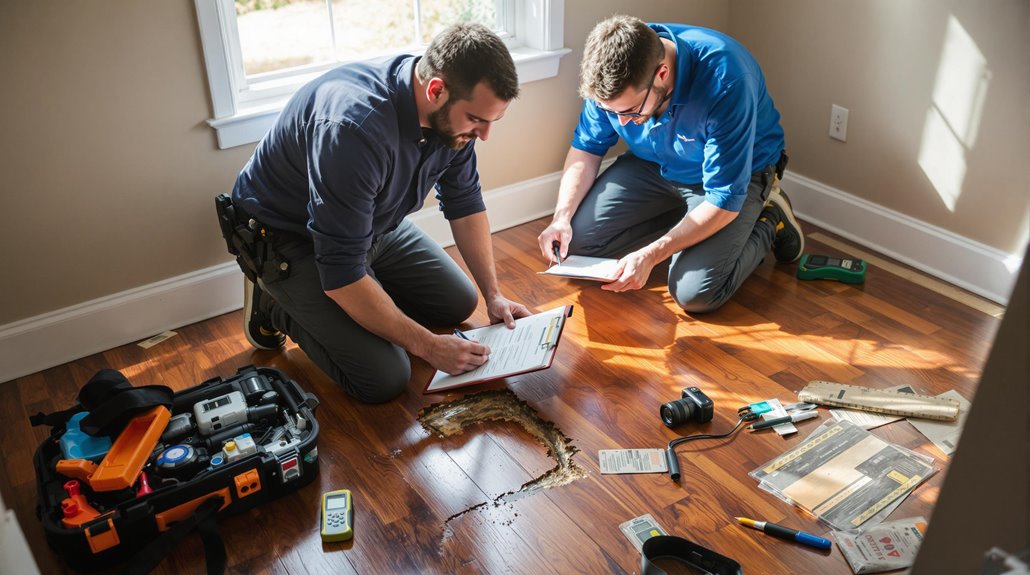
When addressing extensive hardwood floor cupping damage, consulting a public adjuster can provide critical expertise in steering insurance claims and securing ideal compensation.
Public adjusters conduct thorough, objective assessments of floor damage while managing all aspects of the claims process, from documentation to negotiation with insurance providers.
Their professional involvement typically results in markedly higher claim settlements, often three to five times more than unassisted claims, while ensuring proper coverage for both immediate repairs and potential long-term flooring issues.
For maximum benefit, early adjuster involvement is crucial since documenting floor damage immediately after water exposure strengthens the claim's validity.
Expertise In Insurance Claims
Dealing with cupped hardwood floor damage often necessitates maneuvering through complex insurance claims, making the expertise of a public adjuster invaluable.
These professionals possess extensive knowledge of insurance policy interpretation and implement effective claims negotiation strategies to secure ideal settlements for property owners.
Public adjusters provide essential expertise through:
- Thorough analysis of policy coverage specific to hardwood floor damage
- Documentation of moisture-related cupping and associated structural impacts
- Strategic presentation of repair costs and restoration requirements
Their specialized knowledge guarantees proper classification of damage causes, accurate assessment of repair scope, and maximum coverage utilization.
Insurance adjusters navigate complex policy language, identify applicable coverage riders, and leverage industry-specific documentation standards to substantiate claims.
This expertise greatly improves the likelihood of securing adequate compensation for hardwood floor restoration.
Unlike insurance company adjusters who prioritize minimizing costs, independent public adjusters work solely to maximize settlement amounts for the property owner.
Objective Damage Assessment
Securing an objective damage assessment through a public adjuster provides property owners with a thorough evaluation of hardwood floor cupping issues.
These licensed professionals employ specialized tools and methodologies to conduct extensive damage evaluations, ensuring accurate identification of all affected areas and underlying causes.
During the moisture analysis phase, public adjusters utilize industry-standard equipment to measure humidity levels and assess the extent of water damage.
Their expertise helps determine whether the cupping resulted from covered perils, ensuring damaged materials meet replacement criteria according to current industry standards.
This systematic approach documents all losses thoroughly, providing essential support for insurance claims.
The detailed assessment includes coordination with qualified contractors to establish precise repair estimates, ensuring property owners receive appropriate compensation for necessary floor restoration work.
With over 40 states covered by the Public Claims Adjusters Network, property owners nationwide can access professional assessment services for their flooring damage claims.
Streamlined Claim Process
Public adjusters greatly streamline the insurance claims process for cupped hardwood floor damage through systematic documentation and expert negotiation strategies. Their involvement facilitates claims automation while enhancing the overall customer experience through professional management and transparent communication.
Key benefits of utilizing a public adjuster include:
- Automated documentation creation and validation, reducing processing time and errors
- Real-time claim status updates through digital platforms, improving transparency
- Enhanced operational efficiency through optimized workflows and electronic claims processing
Public adjusters leverage advanced technology solutions to expedite claims resolution, ensuring accurate damage assessment and fair compensation.
Their expertise in maneuvering complex insurance procedures, combined with digital documentation systems, considerably reduces administrative burden while maximizing claim outcomes for property owners facing hardwood floor damage.
With settlement rates typically ranging from 5% to 15%, public adjusters often secure significantly higher compensation than policyholders managing claims independently.
Higher Claim Payouts & Settlements
Beyond streamlined processes, the financial advantages of engaging a public adjuster become evident through markedly higher claim settlements for cupped hardwood floor damage. Their expertise in claim strategies and settlement negotiation typically results in substantially increased payouts compared to self-managed claims.
| Settlement Aspect | Public Adjuster Advantage |
|---|---|
| Damage Assessment | Thorough identification of all floor damage patterns |
| Policy Coverage | Maximized utilization of available benefits |
| Documentation | Detailed technical reports with supporting evidence |
| Negotiation Power | Professional representation with proven strategies |
Operating on contingency fees, public adjusters are inherently motivated to secure maximum settlements. Their specialized knowledge in identifying complex damage patterns, combined with tactical negotiation expertise, guarantees ideal compensation for hardwood floor restoration or replacement costs. Public adjusters provide significant value with contingency fee arrangements typically ranging from 5-20% of the final settlement amount.
About The Public Claims Adjusters Network (PCAN)
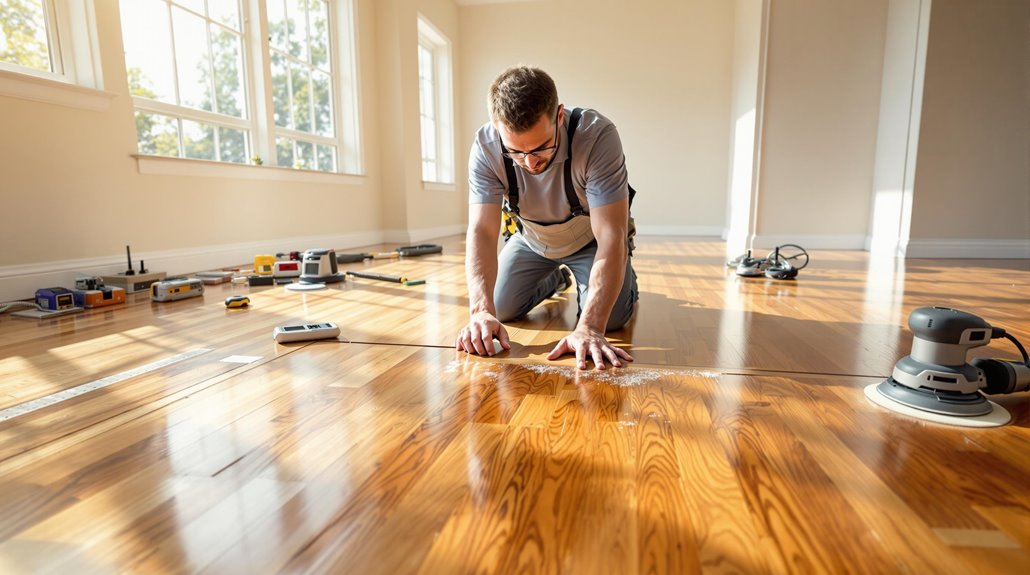
Professional claims management takes on new dimensions with the Public Claims Adjusters Network (PCAN), a consortium of industry leaders including Network Adjusters, NICA, and Allied Public Risk. This partnership leverages over 40 years of claims expertise to deliver thorough solutions for public sector claims management.
- Network Adjusters has processed over 10,000 public sector claims within three years.
- NICA provides specialized CAT adjusters and 24/7 call center operations.
- Allied Public Risk enhances claim success rates through strategic partnerships.
Public Adjusters within PCAN deliver critical services including third-party administration, independent adjusting, trial preparation, and subrogation services.
The network's integrated approach guarantees efficient claims processing while maintaining high-quality standards through customized solutions.
This systematic methodology has established new industry benchmarks in claims management, supported by documented success in client satisfaction and operational excellence.
Frequently Asked Questions
How Long Does Hardwood Flooring Need to Acclimate Before Installation?
The standard acclimation period for hardwood flooring is minimum 3 days, though installation tips recommend monitoring until moisture content equilibrates with surroundings, which may require extended timeframes depending on environmental conditions.
Can Cupped Hardwood Floors Be Fixed Without Professional Help?
When push comes to shove, cupped hardwood floors can be fixed through DIY methods. Proper repair techniques include moisture control, adequate drying time, and systematic sanding and refinishing procedures.
What Humidity Level Is Ideal for Maintaining Hardwood Floors?
Ideal humidity control for hardwood flooring maintenance requires maintaining relative humidity between 30-50%. This range prevents wood expansion and contraction while ensuring structural stability throughout seasonal changes.
Does Homeowner's Insurance Typically Cover Cupped Hardwood Floor Repairs?
Insurance coverage for cupped hardwood flooring damage depends on the cause. Sudden, accidental water incidents are typically covered, while gradual damage from humidity or maintenance issues generally isn't covered.
How Much Does It Cost to Fix Cupped Hardwood Floors?
Fixing cupped hardwood floors costs $2-$8 per square foot, with repair options varying based on flooring materials and damage extent. Total project expenses typically range from $480-$1,708, including professional labor.
References
- https://www.sourcewoodfloors.co.uk/how-to-fix-cupped-hardwood-flooring
- https://www.jeffcoflooring.com/moisture/why-floors-cup/
- https://www.diverseflooring.ca/blog/articles/how-to-fix-hardwood-floor-cupping-tips-and-solutions
- https://www.quickshinefloors.com/how-to-fix-hardwood-floor-cupping/
- https://www.impressionsflooring.com/wood-floor-cupping-why-does-it-happen-what-can-you-do/
- https://www.wagnermeters.com/moisture-meters/wood-info/spotting-trouble-hardwood-floors/
- https://basementmasterswaterproofing.com/blog/what-causes-my-cupping-hardwood-floors-basement-masters/
- https://www.fromtheforest.com/blogs/fromtheforest/floor-cupping-what-you-need-to-know
- https://www.gsa.gov/real-estate/historic-preservation/historic-preservation-policy-tools/preservation-tools-resources/technical-procedures/repairing-cupped-floorboards
- https://www.springcarpets.com/blog/articles/understanding-hardwood-floor-cupping-causes-effects-and-solutions
